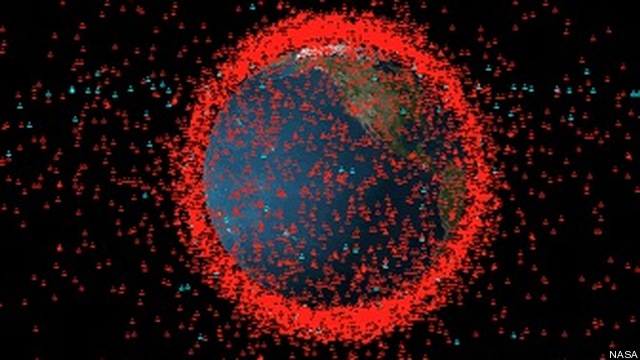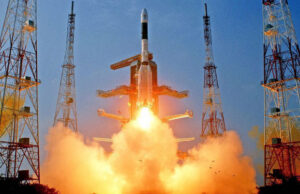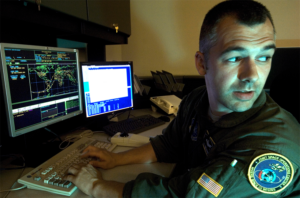CSIS On The Second Space Age: ‘Diverse, Disruptive, Disordered And Dangerous’
Posted on

Space debris in orbit around Earth
WASHINGTON: We knew space was congested, contested and all that. But the folks at CSIS have recast that to good effect in a report actually worth reading in detail. The Second Space Age (yes, they’ve come up with a catchy rubric!) is, they say, more diverse, disruptive, disordered, and dangerous than the first space age.”
How fundamentally have things shifted since the Soviets first made it to orbit and America first made it to the Moon — and the NRO launched Keyholes and lots of neat missile warning satellites and…?

Indian satellite launch
“From 1991 through 2016, 43 percent of new satellites and 39 percent of launches have been from nations other than the United States and Russia. Moreover, since 2014, a majority of satellites and a majority of launches have been from nations other than the United States and Russia—primarily China, Japan, Europe, and India.” Translation: we’re not the hot space leader we once were. Neither are the Russians.
And our space advantage for the military, cemented through our use of GPS-guided weapons, satellite communications and tactical intelligence, is under much greater threat today. For almost 50 years, while military uses of space were common, the consensus among the tiny group of space powers was that they would not fight in space, probably. Today, the assumption is that war will include space. Satellites will be shot at, dazzled and targeted by directed energy weapons.
“The U.S. military uses its space systems across the full spectrum of conflict, from gray zone conflicts to high-end major theater war. It is only natural to expect that adversaries will attempt to disrupt, degrade, or destroy these systems. What is different in the second space age is not that war could extend into space, but rather that a wider array of adversaries can begin to fight back against U.S. space capabilities —both from the ground and from space,” the report notes.

Joint Space Operations Center
Among the reasons for the expansion of the envelope of conflict is that military satellites used to be closely and exclusively tied to the waging of nuclear war and were thus off limits. Today, by contrast, they “are now being used routinely for conventional warfighting at lower ends of the conflict spectrum. This calls into question whether a nuclear or non-nuclear adversary would be deterred from attacking these systems in a conventional conflict—especially if these systems are actively providing the U.S. military with a substantial advantage in that conflict.” All this means that the second space age “is more dangerous.”
The report does a commendable job of detailing the array of threats facing space-based assets, beyond the spectacular but irrevocable use of missiles or other delivery systems (specially modified F-15s anyons?) to destroy a satellite.

X-37B
One of my personal favorites would be the use of the X-37B space plane or other satellites to mess with an enemy’s assets. I think the fact that the X-37B is now flying for very extended periods of time can lead us to conclude that the US is using it both for ISR and for deterrence. The report’s authors also point to space mines, which could “quietly trail a target satellite and detonate a small charge when commanded. A co-orbital satellite can also grab another satellite to move or de-orbit it. It could also attach itself to the target satellite and interfere with that satellite’s operation. A satellite can also be maneuvered into a crossing orbit to intercept a target satellite while giving little warning.”

SpaceX Falcon 9 rockets in production.
There are high-powered microwave (HPM) weapons that can scramble or completely fry a bird’s electronics. “A ‘front-door’ HPM attack uses a satellite’s own antennas as an entry path, while a ‘back-door’ attack attempts to enter through small seams or gaps around electrical connections and shielding,” the reprot explains. “A front-door attack is more straightforward to carry out, provided the HPM is positioned within the field of view of the antenna that it is using as a pathway, but it can be thwarted if the satellite uses circuits designed to detect and block surges of energy entering through the antenna. In contrast, a back-door attack is more challenging because it must exploit design or manufacturing flaws, but it can be conducted from any angle relative to the satellite.” One thing that makes these weapons useful is that attribution is extremely difficult. But the attacker also has little idea if their attack actually worked.
Jamming and GPS spoofing are fun tools for all, as well. The report says that “even encrypted military GPS signals can be spoofed by a device that records the encrypted signal and rebroadcasts it with a slight delay, a process known as ‘meaconing…’ By gradually adjusting the amount of time delay inserted, an autopilot system using GPS for navigation can be tricked into thinking it is flying straight and level, when in fact it is climbing, descending, or turning.” (Yet another reason GPS 3 and the OCX ground stations are so badly needed.)
One of the greatest weaknesses to space assets are not in space. They are the Earth-bound ground stations which control the birds, monitor their health and receive their operational data.

Proposed OCX satellite constellation
“To reduce the dependence on ground stations, some military space systems use inter-satellite links to transmit data directly between satellites without passing through an intermediary ground station,” the report says. “Ground stations are vulnerable to kinetic physical attack by several means. Guided missiles and rockets can be used to attack ground stations from range, while rocket-propelled grenades and small arms fire can be used to disable ground station antennas at close range. Ground stations can also be disrupted by attacking the electrical power grid, water lines, and the high-capacity communications lines that support them.”
As I reported when I was at Space News, lasers can be used to temporarily blind satellites with optical sensors, although it’s difficult to inflict permanent damage because of the energy required to deliver a coherent beam. The US and China have both executed tests of lasers against satellites. The Chinese test we know about did not cause permanent damage to the satellite they dazzled.
My favorite truth pounded into me time and again by rocket scientists and national security space experts is that physics decide most of what humans can do in space. So while we can do many of the things outlined above, most of them are pretty hard to do — destroying satellites or jamming them precisely (we often jam ourselves...) — and would send a very clear signal to the United States that we were at war with the offender if it happened more than once.
Much of the study grapples with the ever-difficult challenge of deterrence. The authors take the standard route of comparing space and nuclear warfare conduct for deterrence lessons. They do offer an intriguing third way, what they call a “catalytic strategy.”

North Korean missile test
“A catalytic space strategy would attempt to convince a great power patron (likely the United States) to intervene on behalf of one of its allies if that ally was attacked in space. For example, the Japanese reliance on payloads hosted on U.S. satellites could force the United States to consider responding to an attack made by China against Japanese space capabilities,” the report’s authors say.
To be more effective at space deterrence, they conclude the US needs “a more refined U.S. declaratory policy that identifies and sequences U.S. escalation options in response to an attack in space.” They offer a sort of escalation ladder, saying the US could apply international pressure, jam communications to or from satellites, dazzle or blind imaging satellites, use cyber attacks to temporarily disable satellites and their command and control systems, change a satellite’s orbit, use special operations troops or missile attacks against ground systems, launch anti-satellite strikes, and, finally, use nuclear weapons. Parallel to these steps, obviously, we could use other military, diplomatic, informational, or economic measures to change our adversary’s behavior.
The report’s authors are Todd Harrison, Zack Cooper, Kaitlyn Johnson and Thomas G. Roberts, all of the Center for Strategic and International Studies.
Subscribe to our newsletter
Promotions, new products and sales. Directly to your inbox.
